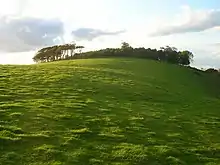| Site of Special Scientific Interest | |
 Chanctonbury Ring | |
| Location | West Sussex |
|---|---|
| Grid reference | TQ 140 119[1] |
| Interest | Biological |
| Area | 82.7 hectares (204 acres)[1] |
| Notification | 1985[1] |
| Location map | Magic Map |
Chanctonbury Hill is an 82.7-hectare (204-acre) biological Site of Special Scientific Interest west of Steyning in West Sussex.[1][2] Part of it is Chanctonbury Ring, an early Iron Age hillfort which contains two Romano-Celtic temples and which is a Scheduled Monument.[3]
This site on the steep slope of the South Downs is mainly woodland with some areas of chalk grassland. A dew pond has great crested newts, a species protected under the Wildlife and Countryside Act 1981. More than sixty species of breeding birds have been recorded, including meadow pipits, corn buntings and green woodpeckers.[4]
References
- 1 2 3 4 "Designated Sites View: Chanctonbury Hill". Sites of Special Scientific Interest. Natural England. Retrieved 19 April 2019.
- ↑ "Map of Chanctonbury Hill". Sites of Special Scientific Interest. Natural England. Retrieved 19 April 2019.
- ↑ Historic England. "Chanctonbury Ring hillfort and Romano-Celtic temples (1015114)". National Heritage List for England. Retrieved 19 April 2019.
- ↑ "Chanctonbury Hill citation" (PDF). Sites of Special Scientific Interest. Natural England. Retrieved 19 April 2019.
Wikimedia Commons has media related to Chanctonbury Hill.
This article is issued from Wikipedia. The text is licensed under Creative Commons - Attribution - Sharealike. Additional terms may apply for the media files.